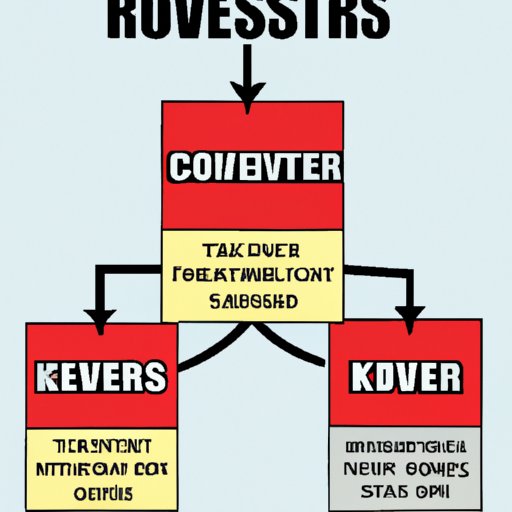Introduction
A hostile takeover is a corporate acquisition in which the target company’s board of directors does not approve of the purchase. The acquirer typically has to make an offer directly to the shareholders in order to gain control of the company. Hostile takeovers can be a contentious process, as they often involve a battle between the target company’s board of directors and the acquiring company.
Definition of Hostile Takeovers
A hostile takeover occurs when one company attempts to take over another without the approval or consent of the target company’s board of directors. This type of takeover is considered hostile because the target company’s board of directors does not support the transaction. In some cases, the target company’s board of directors may even actively oppose the takeover attempt.
Overview of the Process and Outcomes
In a hostile takeover, the acquiring company attempts to purchase enough shares of the target company to gain control of it. The acquiring company typically makes an offer directly to the shareholders of the target company, offering them a premium above the current market price of the stock. If the offer is accepted by enough shareholders, the acquiring company will gain control of the target company.
Once the takeover is successful, the acquiring company will typically replace the existing management team with their own. They may also restructure the company and implement cost-saving measures. Depending on the situation, the acquiring company may also attempt to merge the two companies together, creating a larger entity.

Pros and Cons of Hostile Takeovers
Hostile takeovers can have both positive and negative effects for both the acquiring and target companies. Here are some of the potential benefits and drawbacks:
Financial Benefits
The most obvious benefit of a hostile takeover is that the acquiring company can purchase a target company at a discounted rate. This can be beneficial for both companies, as the acquiring company can gain access to new markets or technologies at a lower cost, while the target company can receive a premium above the current market price of their stock.
Potential Disadvantages
However, hostile takeovers can also be detrimental to both companies. For the target company, a hostile takeover can result in significant job losses, as the acquiring company may seek to reduce costs by cutting jobs. Additionally, the target company may be unable to negotiate favorable terms with the acquiring company, resulting in unfavorable outcomes for the shareholders.
Different Types of Hostile Takeovers
There are several different types of hostile takeovers that can occur. The most common type is a tender offer, in which the acquiring company offers to buy a certain number of shares of the target company at a premium. Other types of hostile takeovers include proxy battles and open market tender offers.
Tender Offers
In a tender offer, the acquiring company offers to purchase a specific number of shares of the target company at a premium. The offer must be accepted by enough shareholders in order for the acquiring company to gain control of the target company. If the offer is successful, the acquiring company replaces the existing management team and restructures the company.
Proxy Battles
A proxy battle is a type of hostile takeover in which the acquiring company attempts to persuade shareholders to vote in favor of the takeover. The acquiring company will typically launch a public relations campaign in order to sway the opinion of shareholders. If the acquirer is successful, they will gain control of the target company.
Open Market Tender Offers
An open market tender offer is similar to a regular tender offer, except that the acquiring company can purchase shares in the open market instead of making a direct offer to shareholders. This type of hostile takeover can be more difficult to execute, as the acquiring company must purchase enough shares in the open market to gain control of the target company.

Legal Framework Surrounding Hostile Takeovers
Hostile takeovers are regulated by various laws and regulations. Regulatory bodies such as the Securities and Exchange Commission (SEC) have the authority to intervene in hostile takeovers if they believe that the proposed transaction is not in the best interests of the shareholders.
Role of Regulatory Bodies
Regulatory bodies such as the SEC have the power to review hostile takeover bids and determine whether or not they should be approved. These bodies may require the acquiring company to make certain concessions in order for the takeover to be approved, such as providing additional information to shareholders or agreeing to certain conditions.
Shareholder Rights
Shareholders also have certain rights when it comes to hostile takeovers. Shareholders have the right to accept or reject any offer made by the acquiring company, and they can also launch a lawsuit against the acquiring company if they feel that their rights have been violated. Additionally, shareholders can organize and launch a proxy battle against the acquiring company if they do not support the proposed takeover.

Recent Examples of Hostile Takeovers
In recent years, there have been numerous examples of hostile takeovers. Here are two notable examples:
Example 1
In 2015, Kraft Heinz attempted to acquire Unilever in a hostile takeover bid. The bid was ultimately rejected by Unilever’s board of directors, who argued that the offer undervalued the company. Despite the rejection, the bid sparked a debate about the role of hostile takeovers in the corporate world.
Example 2
In 2016, Allergan was the subject of a hostile takeover bid from Valeant Pharmaceuticals. Allergan’s board of directors rejected the offer, arguing that it significantly undervalued the company. The takeover attempt ultimately failed, but it highlighted the potential risks associated with hostile takeovers.
Impact of Hostile Takeovers on Shareholder Value
Hostile takeovers can have a significant impact on shareholder value. On the one hand, hostile takeovers can result in increased financial returns for shareholders, as the acquiring company may pay a premium for the target company’s stock. On the other hand, hostile takeovers can also result in decreased shareholder value, as the target company may not be able to negotiate favorable terms with the acquiring company.
Positive Impacts
In some cases, hostile takeovers can be beneficial for shareholders. For example, the acquiring company may pay a premium for the target company’s stock, resulting in increased returns for shareholders. Additionally, the acquiring company may also implement cost-saving measures that can increase profitability and shareholder value.
Negative Impacts
However, hostile takeovers can also have a negative impact on shareholder value. For example, the target company may not be able to negotiate favorable terms with the acquiring company, resulting in decreased returns for shareholders. Additionally, the acquiring company may seek to reduce costs by cutting jobs, resulting in decreased shareholder value.
Conclusion
Hostile takeovers can be a contentious process, with both the acquiring and target companies having to navigate complex legal and financial issues. While hostile takeovers can have both positive and negative impacts on shareholder value, it is important for both parties to understand the legal framework surrounding these transactions and the potential risks and rewards associated with them.
(Note: Is this article not meeting your expectations? Do you have knowledge or insights to share? Unlock new opportunities and expand your reach by joining our authors team. Click Registration to join us and share your expertise with our readers.)
